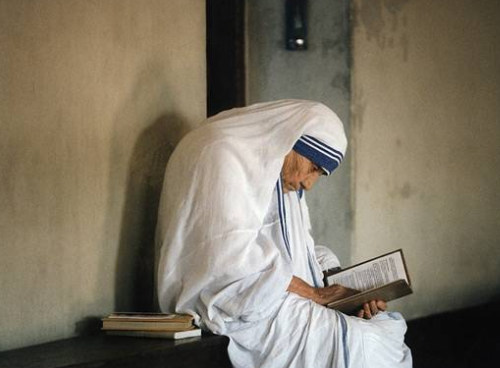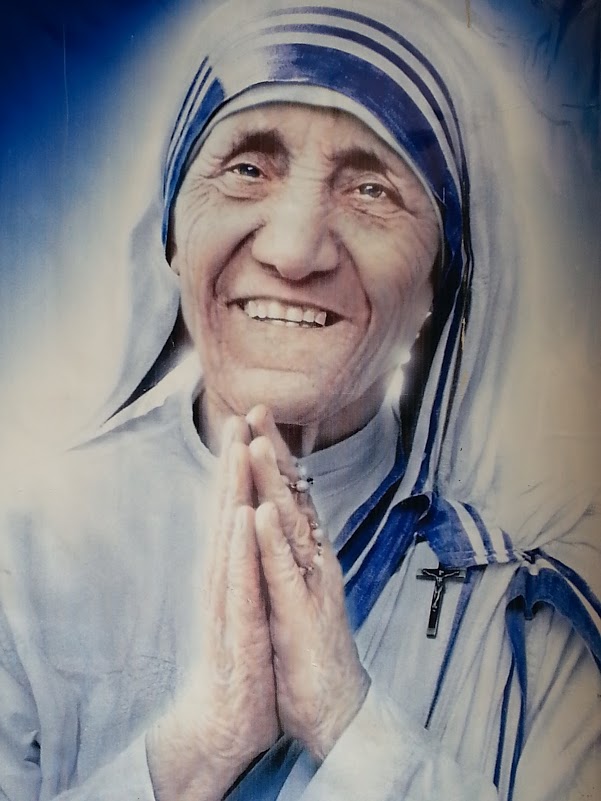Mother Teresa
Mother Teresa dedicated her life to helping the poor, the sick, and the dying around the world, most notably in India. Born Agnes Gonxha Bojaxhiu on August 26th 1910 in Skopje, Yugoslavia, where she had a comfortable childhood. Deciding to become a nun in 1928, she joined the Sisters of Loreto in Dublin Ireland. After several months in Ireland she left to join the Loreto convent in Darjeeling, India. On May 24, 1931, she took the name of “Teresa” in honor of St. Teresa of Avila, a sixteenth-century Spanish nun.

Assigned to teach at St. Mary’s High School for Girls in Calcutta, south of Darjeeling, she was troubled by the poverty she witnessed, as the city was crowded with beggars, lepers, and the homeless. In 1946, Mother Teresa left her position at St. Mary’s to care for the needy in the slums of Calcutta. After receiving the consent of her archbishop, she began her work, focusing her efforts on poor children in the streets, teaching them how to read and how to care for themselves.
In 1948, Pope Pius XII granted Mother Teresa permission to live as an independent nun. After studying nursing for three months, she returned to Calcutta to found the Missionaries of Charity. For her habit she chose a plain white sari with a blue border, and a simple cross pinned to her left shoulder.
In 1965, Pope Paul VI placed the Missionaries of Charity directly under the control of the papacy (the office of the pope) and authorized Mother Teresa to expand the order outside of India. Centers to treat lepers, the blind, the disabled, the aged, and the dying were soon opened worldwide, including one in Rome in 1968. Mother Teresa also organized schools and orphanages for the poor. The Brothers of Charity, the male companion to the Sisters of Charity, was formed in the mid-1960s to run the homes for the dying.
In 1971, Pope Paul VI honored Mother Teresa by awarding her the first Pope John XXIII Peace Prize. The following year, the government of India presented her with the Jawaharlal Nehru Award for International Understanding. In 1979, she received the Nobel Peace Prize. Mother Teresa accepted all of these awards on behalf of the poor, using any money that accompanied them to fund her centers. By 1990 over 3,000 nuns belonged to the Missionaries of Charity, running centers in 25 countries. The Blessed Mother Teresa died on September 5, 1997. The beatification of Mother Teresa was conducted Oct. 19, 2003 by Pope John Paul II. On September 4, 2016, Mother Teresa was canonized a saint by Pope Francis.
St. Teresa of Calcutta, pray for us.
Feast Day: September 5th.
Mission Trips
Fast Pace - Simple Hotels - Local Restaurants - Cultural Experiences - All Inclusive
Attend Mass at the tomb of Mother Teresa, serve the poorest of the poor with the MC sisters, visit the very inspiring museum, and mingle with other volunteers from all over the world. One day we’ll make a special trip through the slums of Calcutta to visit the Leper Colony that was founded 5 decades ago. Longer trips will include sightseeing and short trips to other popular Catholic sites across the country. There will be time to relax, explore and shop locally as well.
Catholic Pilgrimages
Relaxed Pace - Star Hotels - Fancy Restaurants - Cultural Experiences - All Domestic Travel included
Walk in the footsteps of 3 amazing Saints – Mother Teresa, St. Thomas the Apostle, and St. Francis Xavier. Encounter the rich culture and unique traditions from all corners of the subcontinent. Our special attractions include Mass at the tomb of Mother Teresa, 2000 year old Churches built by St. Thomas and the incorrupt body of St. Francis Xavier. Enjoy the majestic Taj Mahal and the other beautiful monuments. Relax on the beautiful beaches of Goa and retreat on a houseboat in the pleasant backwaters of Kerala.

“Let us do something beautiful for God.”
“The fruit of silence is prayer,
the fruit of prayer is faith,
the fruit of faith is love,
the fruit of love is service,
the fruit of service is peace.”
“Find your own Calcutta. Find the sick, the suffering, and the lonely, right where you are — in your own homes and in your own families, in your workplaces and in your schools. You can find Calcutta all over the world, if you have eyes to see.”
“The greatest disease in the West today is not TB or leprosy; it is being unwanted, unloved and uncared for. We can cure physical diseases with medicine, but the only cure for loneliness, despair and hopelessness is love. There are many in the world who are dying for a piece of bread, but there are many more dying for a little love. The poverty in the West is a different kind of poverty — it is not only a poverty of loneliness but also of spirituality. There’s a hunger for love as there is a hunger for God.”
“Yesterday is gone. Tomorrow has not yet come. We have only today. Let us begin.”